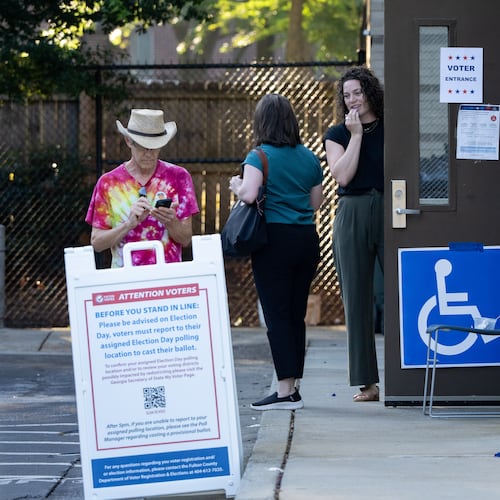The Georgia Senate and House passed maps redrawing their own district lines on Friday, moving the Legislature one step closer to responding to an order from a federal judge requiring the creation of seven more majority-Black districts.
Voting mostly along party lines, Republican-led lawmakers in each chamber approved the political maps they say will satisfy the judge’s order. Democrats opposed the bills and presented their own versions of redrawn maps.
Republicans said they complied with U.S. District Judge Steve Jones’ ruling that ordered the General Assembly to redraw the state maps it passed two years ago because he found they illegally weakened Black voting strength. Democrats said the maps don’t do enough.
“We didn’t draw the districts this way in 2021. We don’t want to redraw these districts now. We’re doing this because we were sued by Democratic-leaning groups,” said Senate Redistricting Chairwoman Shelly Echols, a Republican from Alto. “Our primary goal in creating this district plan is to comply with Judge Jones’ order in every respect.”
Black voters overwhelmingly support Democrats while most white voters in Georgia back Republicans.
But while the GOP’s redistricting proposal adds more majority-Black districts — five in the House and two in the Senate — it minimizes opportunities for Democrats to make gains. Republicans drew the maps in a way to protect every incumbent in the Senate and likely give up just two seats in the House.
Credit: Miguel Martinez
Credit: Miguel Martinez
Republicans currently hold a 33-23 majority in the state Senate and a 102-78 advantage in the state House under GOP-drawn maps from 2021, a lead that would remain mostly intact under the new district borders.
Under the House map, which passed 101-77, the Republican majority protected its partisan advantage by moving three sets of Democratic incumbents into the same districts, forcing half of them out of office in next year’s election. One pair of GOP incumbents is also drawn together.
“This map is an undemocratic, un-American, blatant exercise of partisan gerrymandering,” said Minority Whip Sam Park, a Democrat from Lawrenceville whose district was merged with Democratic state Rep. Gregg Kennard’s. “Georgians deserve better. We can do better than this unlawful Republican map that puts partisan politics before the citizens of Georgia.”
Senate Democrats accused their Republican colleagues of using “smoke and mirrors” to make it appear as though they were complying with the judge’s order by adjusting two Atlanta districts that are held by Democrats to have a majority of Black voters.
But Republicans said they obeyed the judge by increasing Black districts, but they didn’t have any obligation to draw districts in a way that would result in more seats for Democrats. The maps passed the Senate 32-23.
“The argument was made that we somehow broke the law by complying with the judge’s order,” said House Redistricting Chairman Rob Leverett, a Republican from Elberton. “I wish we didn’t have to do this, I really wish we didn’t, but we’ve been ordered to.”
Credit: Jason.Getz@ajc.com
Credit: Jason.Getz@ajc.com
Democrats objected to maps that altered several districts that already have Black majorities without increasing the chances for greater representation.
“What everyone in this chamber already knows is that this map does nothing to strengthen Black voting power in the areas identified,” said state Sen. Tonya Anderson, a Democrat from Lithonia whose district was identified in the judge’s order as violating the Voting Rights Act of 1965. “The majority claims that they value the votes and the voices of Black people and Black women. But all evidence is to the contrary.”
Redistricting of the Georgia General Assembly preceded a more nationally prominent change: a revised map for the U.S. House, where Republicans hold a 9-5 advantage in the state. Jones ordered lawmakers to create an additional U.S. House district with a Black majority.
Though Black residents accounted for nearly half of Georgia’s overall population growth since 2010, Jones’ decision concluded that redistricting prevented adequate opportunities for representation.
Now that new legislative maps have passed their first chambers, they will next be considered by the other body: The Senate will vote on the House districts, the House on the Senate. Revised maps must be signed into law by the end of next week to meet Jones’ Dec. 8 deadline.
Georgia has appealed Jones’ ruling, but legislators said the new political boundaries they pass in the next few days will likely be used in next year’s elections if the judge doesn’t reject them.
Keep Reading
The Latest
Featured





